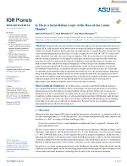Is There a Semi-Molten Layer at the Base of the Lunar Mantle?

Publication date
2023Published in
Journal of Geophysical Research. PlanetsVolume / Issue
128 (7)ISBN / ISSN
ISSN: 2169-9097Metadata
Show full item recordCollections
This publication has a published version with DOI 10.1029/2022JE007652
Abstract
Parameterised by the Love number k(2) and the tidal quality factor Q, and inferred from lunar laser ranging (LLR), tidal dissipation in the Moon follows an unexpected frequency dependence often interpreted as evidence for a highly dissipative, melt-bearing layer encompassing the core-mantle boundary. Within this, more or less standard interpretation, the basal layer's viscosity is required to be of order 10(15)-10(16) Pa s and its outer radius is predicted to extend to the zone of deep moonquakes. While the reconciliation of those predictions with the mechanical properties of rocks might be challenging, alternative lunar interior models without the basal layer are said to be unable to fit the frequency dependence of tidal Q. The purpose of our paper is to illustrate under what conditions the frequency-dependence of lunar tidal Q can be interpreted without the need for deep-seated partial melt. Devising a simplified lunar model, in which the mantle is described by the Sundberg-Cooper rheology, we predict the relaxation strength and characteristic timescale of elastically accommodated grain boundary sliding in the mantle that would give rise to the desired frequency dependence. Along with developing this alternative model, we test the traditional model with a basal partial melt; and we show that the two models cannot be distinguished from each other by the available selenodetic measurements. Additional insight into the nature of lunar tidal dissipation can be gained either by measurements of higher-degree Love numbers and quality factors or by farside lunar seismology.
Keywords
Moon, tidal dissipation, interior structure,
Permanent link
https://hdl.handle.net/20.500.14178/2287License
Full text of this result is licensed under: Creative Commons Uveďte původ 4.0 International






